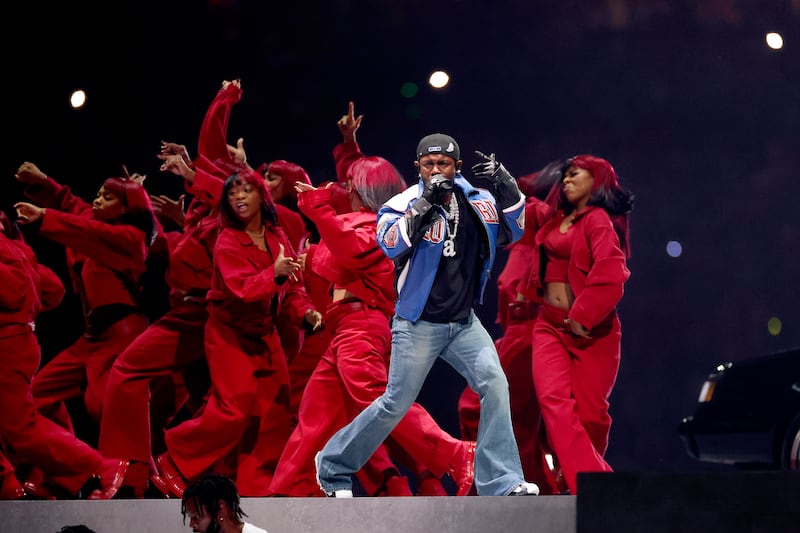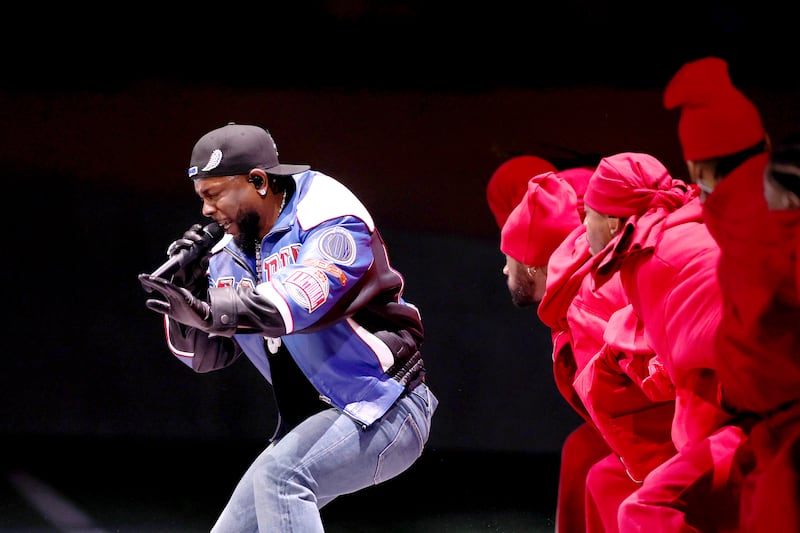The Super Bowl half-time show is Plato’s perfect form of pomp and ceremony, a corporate-sponsored, highly choreographed musical performance used to entice people who don’t follow the NFL into watching TV to secure even higher ad fees from Doritos and Dunkin’ Donuts. Over the years it’s provided moments of great spectacle: Prince playing Purple Rain in the rain, Rihanna announcing her pregnancy flanked by hundreds of sperm-looking dancers in duvet drip – but it’s never been a site of serious artistry. Its biggest controversies – Janet Jackson’s nip slip, MIA’s middle finger – have been teenage in their puerility.
Could that change with the arrival to the Super Bowl stage of Kendrick Lamar, one of this decade’s great public intellectuals – a Pulitzer prize-winning rapper who has transformed the possibilities of hip-hop? It’s an unlikely match for the NFL in an ordinary year, but performing in front of a president who has attacked intellectualism, Black activism and the communities in which Lamar was raised, it felt momentous before it even began.
But Lamar was not necessarily looking to make a statement. He’s in the most mischievous part of his career and at the crest of his mainstream popularity: in 2024 he released a series of duelling diss tracks with Drake, which culminated in Not Like Us – a song that spent the summer atop the Billboard 200. It’s a joyous song of defiance, but one with a churlish undertone that doesn’t fit with the Super Bowl’s inclusivity. So which Kendrick would be arriving in New Orleans? The prophet or the provocateur?
In the end we got flavours of both, with an uneven but ambitious set that was arguably the most esoteric in the Super Bowl’s history, perhaps at the expense of landing a knockout blow. It began with Samuel L Jackson as Uncle Sam, playing the American machine that berated Lemar: “It’s your Uncle Sam, and this is the great American game!”
RM Block
Lamar began the show atop a 1987 Buick Grand National GNX, the rare car for which his album is named. He performed an unreleased and unnamed track, known on the Kendrick Lamar subreddit as Bodies, an early sign that he wasn’t in New Orleans to play crowd pleasers. His outfit also spoke to a sense of self-possession: he wore a varsity jacket by the British designer Martine Rose and the most incredible pair of boot-cut bellbottom jeans – something straight off the rack from mid-00s American Eagle.

The set warmed up with Squabble Up and Humble as dancers flooded the stage dressed in red, white and blue tracksuits, a nod both to the Americana of the occasion and potentially a moment of unity between Compton’s two rival gangs. When the all-African American dance cast started to interplay to form the American flag, it was a moment that felt weighted with significance as Donald Trump looked on (and was rumoured to have left shortly after).
As Uncle Sam Jackson yelled at Lamar that he was “too loud, too reckless, too ghetto” (perhaps in a precursor to how this set will be reviewed in the red states), Lamar moved into an expansive set that resembled a tarmac Compton street corner, another impressive set that was reminiscent of Es Devlin’s Compton street corner that Lamar performed on with Dr Dre, Snoop Dogg and Eminem at the Super Bowl two years ago.
It felt at times more like a theatrical play than a half-time show, with dense layered flows and an interplay of dance, Jackson’s spoken-word moments and Lamar album tracks that didn’t always combine to make an obvious point. Lamar is able to deploy one of the greatest flows in the history of rap, but the onslaught of complex verses didn’t always work in this arena and you occasionally longed for a rousing anthem like Alright or Bitch, Don’t Kill My Vibe.
[ Super Bowl: Eagles soar to 40-22 win over Chiefs in New OrleansOpens in new window ]
But things changed halfway through the set when he teased Not Like Us, in a funny interplay with four female dancers. As the opening bars of the song played over the PA, Kendrick joked: “I want to perform their favourite song, but you know they love to sue,” a reference to Drake’s ongoing defamation lawsuit against the pair’s shared record label, Universal Music. In the week leading up to the Super Bowl there were some rumours that the lawsuit would prevent the song being performed.
And for a moment it seemed like it might be. Instead of launching into it, he played Luther and All the Stars, his pair of songs with SZA, whose soaring vocal gave the set a more layered atmosphere and useful counterbalance. Jackson even acknowledged that these more melodic numbers would appease doubting sports fans at home: “That’s what America wants – nice and calm,” he shouted.

But then Kendrick slammed on the breaks and swerved in the opposite direction, finally unleashing Not Like Us and it felt euphoric. He revealed a maniacal grin, looking straight down the camera as he said “Hey Drake”, before launching into his ruinous screed. He did tone down some of the harshest blows – self-censoring the word “paedophile”, likely at both his lawyers’ and censors’ request – but still screeched the devastating lyric “Tryna strike a chord and it’s probably A minor”, flanked by huge flags that showed small children pointing to a lower-case A. As a final blow, Serena Williams, an ex-girlfriend of Drake, was seen crip-walking by a lamp-post. The Chiefs might have been losing by 27 points at half-time, but it was Drake at that moment who was the biggest loser in North America.
Kendrick himself has always seen himself more as an eyewitness than an activist – or as he put on Family Ties, “I been duckin’ the social gimmicks/I been duckin’ the overnight activists.”
This was a classy, intelligent set that chose artistry over easily meme-able moments. Instead the most obvious protest was not seen on TV but in the stadium, as someone managed to join the throng and raise a Palestinian and Sudanese flag atop Kendrick’s GNX. One of the most intriguing things about Lamar is you’ll never know if the protester was storming the stage or a planned part of the set. – Guardian



















